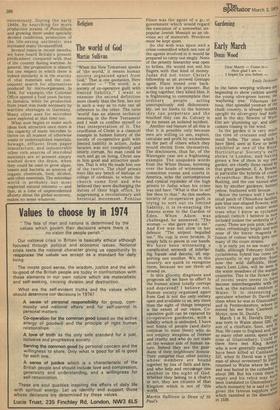Gardening
Early March
Denis Wood
Dear March — Come in—. How glad I am — I hoped for you before —
Emily Dicin In the lanes weeping ow beginning to show catkins among wiliks a sroen the ou n g olive-greentr e e vbu rl enauvme s ; "ohne. Iona, that splendid yeoman of the chalk country, is already holding upright its silver-grey leaf buds. and in the sky, flowers of Wych Elm are 'plumming up', and alder catkins tossing in the wind. In the garden it is very much the time of crocuses and other small bulbs. The ones which I have liked, seen at Kew or being, exhibited at one of the Royal Horticultural Society's earlY shows in London, and having grown a few of them in my own garden, are chiefly those raised bY that great gardener, E. A. Bowles' in particular the hybrids of crocus chrysanthus: Blue Bird, SnoW Bunting, and the one named after him by another gardener, butterY yellow, feathered with bronze. Below the terrace wall I have a small patch of Chinodoxa pale blue star-shaped flowers, With white centres, and under some trees what I know as cyclamen atkinsii (which I believe is now included undeer the umbrella of C. coum). These are pale pink, almost white, refreshingly bright and witli none of the hectic magenta fusion of colour which gets int° many of the coum strains. It is early yet to see many dalfodils, although February Gold, a cyclamineus hybrid has come out punctually in my garden. Soon now the wild daffoldils, Hou.sman's Lent Lilies, will be seen 111 the water meadows of the warrner, countries. This is the flower that of recent years seems to hav,.ee become interchangeable with leek as the national emblem n' Wales. 'It is interesting t° speculate whether St David saW them when he was at GlastonburY and in Pembrokeshire, where he moved his see from Caerleon tn Mynyr, now St. David's. he March 1 is St. David's Day; was born in Wales about 520, th,et son of a chieftain, Sant, and Non. He came to England and, 0,, so many other saints, spent sorn: time at Glastonbury. Could h` there have met King Arthtlfo' who is now generally supposed have been killed at Camlann 537, when St David was a Youri'd' man of about seventeen? St David, returned to Wales where he and was buried in the cathedral 1.1; about 588. But his tomb there i; empty and his relics may havto been translated to GlastonburY,4 which monastry he is said to ha:r given the famous sapphire alt.'r which vanished anished at the dissoluti
in 39 °
































 Previous page
Previous page